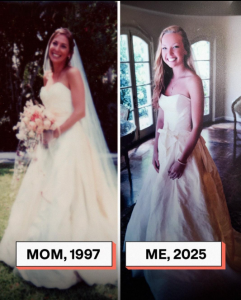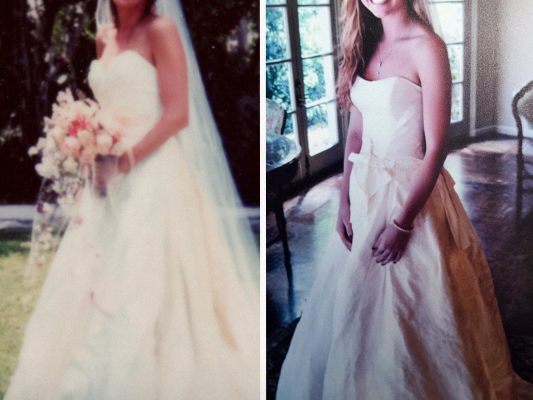
When I was little, I used to sneak into my mother’s closet and pull down the white garment bag that held her wedding dress. It was soft, smelling faintly of lavender and cedarwood from the sachets she’d tucked inside. Even after she passed away when I was ten, that dress was my way of feeling close to her—a tangible memory of the woman whose laugh could fill a house.
I grew up knowing that one day, I wanted to wear that dress when I got married. It wasn’t about fashion or trends. It was about carrying a piece of my mother with me into one of the biggest moments of my life. My father knew that too. Every year when we’d go through her things, I’d remind him, “Don’t forget, I’m wearing Mom’s dress someday.” He would just smile and say, “I’ll make sure it’s safe for you, sweetheart.”
Then, when I was sixteen, he remarried. Her name was Linda. At first, I tried to be open-minded. She was polite, made small talk, and went out of her way to cook my favorite meals. But something always felt off. She had this need to “start fresh,” to rearrange everything my mother had left behind. The house, which once held soft memories of Mom, began transforming into Linda’s vision of modern minimalism. My mother’s antique vases? Donated. Her paintings? “Too outdated.”
I bit my tongue more times than I can count. But the breaking point came one Saturday morning when I came home from a friend’s house and saw black garbage bags lined up at the end of the driveway.
At first, I didn’t think much of it—until I noticed one of the bags was half-open and a piece of delicate lace poked out. My heart sank. I rushed over, ripped the bag open, and there it was. My mother’s wedding dress, wrinkled and dirty, stuffed in with old magazines and discarded clothes.
I froze, then screamed.
Linda came out onto the porch, holding a coffee mug like she didn’t have a care in the world. “Oh, that old thing?” she said, waving her hand dismissively. “It was taking up space. I figured you’d want something new and modern for your wedding someday. That dress was yellowing, and
honestly—kind of depressing.”
I could barely speak. My chest hurt, my vision blurred. “How could you? That was my mother’s!”
Linda rolled her eyes. “You need to move on, sweetie. Your father and I are building a new life together. You can’t cling to the past forever.”
I stormed inside and locked myself in my room, sobbing uncontrollably. My father was away on a business trip that weekend, but I called him immediately. Between hiccupped breaths, I told him everything.
He didn’t say much on the phone—just, “I’ll handle it.”
When he got home Sunday night, the air in the house was thick with tension. I stayed upstairs, listening. My father called Linda into the living room, his voice calm but cold.
“Linda,” he began, “did you throw away Emily’s mother’s wedding dress?”
She hesitated. “It was old, John. I thought it was clutter. She’s being dramatic—”
He cut her off. “You thought wrong.” His tone was sharp enough to make me flinch from upstairs. “That dress was sacred to my daughter. You had no right to touch it.”
“I was trying to help—”
“No,” he said firmly. “You were trying to erase her mother. I’ve let you redecorate, repaint, reorganize—but this? This is crossing a line.”
I crept halfway down the stairs, watching as my father’s jaw tightened.
He continued, “I went through those garbage bags before the trash truck came. The dress is ruined. Beyond repair. And because of that, you’ll make it right.”
Linda frowned. “What’s that supposed to mean?”
“You’re going to pay for professional restoration. Every cent. And while it’s being restored, you’ll clear out every single one of your decorations from this house—everything that replaced something of hers. You’ll store it somewhere else until further notice.”
Her mouth dropped open. “You can’t be serious.”
“Oh, I’m very serious,” he replied. “You need to learn respect—for my daughter and for the woman who came before you.”
For the next few weeks, the atmosphere was painfully awkward. Linda tried to act unbothered, but I could tell she was humiliated. My father didn’t speak to her much, except when necessary. I didn’t either.
True to his word, he sent the dress to a restoration specialist, though they warned him the damage from moisture and dirt might not be completely reversible. When it came back a month later, it wasn’t perfect—the lace was still slightly stained, and the fabric a bit fragile—but to me, it was beautiful. It carried battle scars now, but so did I.
One evening, as I sat with the dress laid out on my bed, my father came in. “She’ll never understand what that meant to you,” he said quietly. “But I do. And I promise you—no one will ever touch this again without your say-so.”
I hugged him tightly. “Thank you for standing up for Mom. For me.”
He smiled softly. “It’s what your mother would’ve wanted.”
Not long after that, Linda packed a bag and left to “stay with her sister for a while.” She didn’t come back. My father filed for divorce a few months later.
Years passed. When I finally met someone I wanted to spend my life with, there was no question about what I’d wear. As I stood in front of the mirror on my wedding day, the same lavender scent faintly lingering in the restored fabric, I felt her with me.
When I walked down the aisle, my father’s eyes glistened with tears. “You look just like your mother,” he whispered before giving me away.
The dress had survived betrayal, time, and pain—just like us. It wasn’t just a piece of fabric anymore. It was proof that love, even when tested, never really fades.
And as I danced that night, the skirt swirling around me like a whisper from the past, I knew one thing for sure: my father didn’t just protect a dress—he protected a memory, a legacy, and a daughter’s heart

